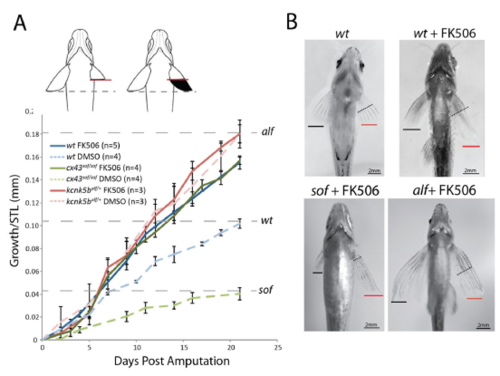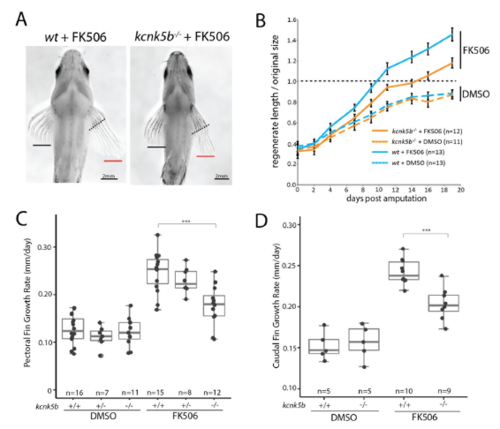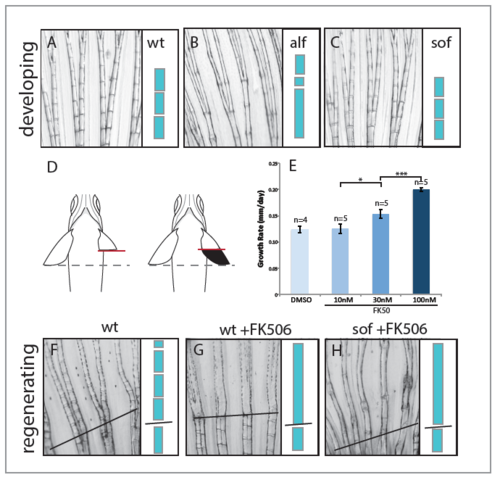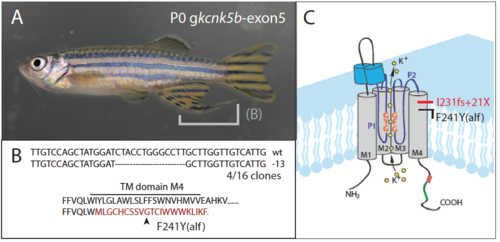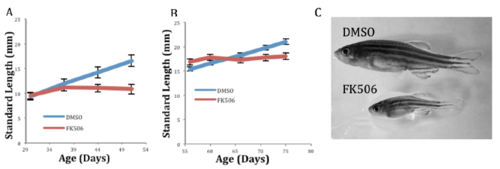- Title
-
Bioelectric-calcineurin signaling module regulates allometric growth and size of the zebrafish fin
- Authors
- Daane, J.M., Lanni, J., Rothenberg, I., Seebohm, G., Higdon, C.W., Johnson, S.L., Harris, M.P.
- Source
- Full text @ Sci. Rep.
|
Calcineurin inhibition is sufficient to override genetic encoding of size. (A) Regenerative growth of zebrafish pectoral fins after resection to ~50% of pre-cut fin length at 0 days post amputation in different genetic backgrounds with short- (cx43sof/sof) or long- (kcnk5balf) fin size relative to wild-type fish. Dashed lines indicate pre-cut pectoral fin length. Data normalized to standard length (STL) of each fish. ANOVA genotype by treatment interaction test F(2,23) = 27.89, p < 0.0001. Pairwise comparisons (ANOVA p-value): alf FK506-alf DMSO (1.0), alf DMSO-sof FK506 (0.25), alf DMSO-wt FK506 (0.25), wt FK506-sof FK506 (1.0), sof FK506-sof DMSO (<0.0001), wt FK506-wt DMSO (0.0013). (B) Representative ventral view of pectoral fins after regeneration. Black line indicates unoperated pectoral fin length. Red line indicates pectoral fin length after treatment with FK506 during regeneration. Black dashed line highlights site of amputation. Growth rate of FK506-treated regenerating caudal fins. (D) Caudal fins were resected to 50% of their original size and treated with FK506. Growth rate is analyzed through 9 days post amputation, when regenerative growth rate for DMSO treated fins begins to slow. Two-tailed t-test p < 0.0007 for suppression of growth in the absence of kcnk5b. Error bars represent ± SEM. PHENOTYPE:
|
|
Kcnk5b mediates the effect of calcineurin in regulating proportion. (A) Example of growth of pectoral fins of wildtype or kcnk5b deletion mutants regenerating after treatment with FK506. Dashed line indicates plane of section; black bar extent of growth of untreated fin; red, resected fin. (B) Growth rates of wildtype and kcnk5b deficient zebrafish. Dashed line, size of original pre-cut fin. Error bars represent ± SEM. ANOVA genotype by treatment interaction F(1,45) = 6.59, p = 0.014. Pairwise comparisons (ANOVA p-value): kcnk5b−/− FK506-wt FK506 (0.0013), kcnk5b−/− DMSO-wt DMSO (1.0), kcnk5b−/− FK506-kcnk5b−/− DMSO (0.022). (C) Growth rate of regenerating fins of different kcnk5b genotypes treated with FK506. Gray dots represent individual fish. Two-tailed t-test p < 0.0002 for suppression of growth in the absence of kcnk5b. Data is from four independent experiments. (C) Representative ventral view of pectoral fins after regeneration. |
|
Proportion and patterning of zebrafish fins is enhanced by calcineurin inhibition. Fin growth occurs through sequential addition of a regular pattern of lepidotrichia hemi-ray dermal bone segments at growing end of the fin. Pattering of fin segmentation in A) wildtype, B) alf and C) sof pectoral fins; stacked blue rectangles model sequential addition and segmentation of individual rays. D) Schematic of regenerating pectoral fin assay to assess relative scaling. One pectoral fin is cut to approximately 50% of original size and allowed to regenerate. Comparisons to the contralateral side enables analysis of previous size and effect of treatment on non-regenerating fins. E) Dose response of FK506 treatment of pectoral fin growth. F-H) Pattern of segmentation of the lepidotrichia in F) regenerating wild-type, or regenerating FK506 treated wild-type or sof fins; solid line, plane of resection. While segments are normally restored during regeneration, regenerating fins treated with FK506 show elongated segmentation after regeneration similar to the alf phenotype (B). Error bars represent ± SEM. * p-value < 0.05. *** p-value < 0.001. |
|
Deletion screen of kcnk5b reveals essential role of C-terminus. Using specific guide RNAs against the last exon of knck5b encoding the last transmembrane and cytoplasmic tail of the channel, we screened injected founders for evidence of overgrowth. We identified localized clones having specific overgrowth of the fins. B) Analysis of the changes in the overgrown tissues demonstrated presence of local deletions in kcnk5b predicted to cause truncation of the channel in a comparable location as to the alf mutation (C). |
|
Growth deficit during FK506 treatment of juveniles. Wild-type juvenile zebrafish treated with FK506 did not grow when treated starting at ages of 30 days (A) or 55 days (B). C) Representative image of stunted growth in FK506 treated fish relative to DMSO treated siblings. n=10 fish per group. Error bars represent ± SEM. |

